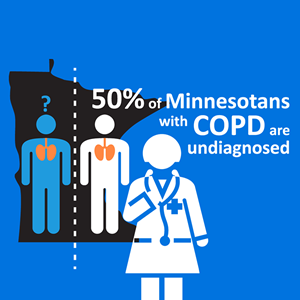Chronic Obstructive Pulmonary Disease (COPD): MNPH Data Access - MN Dept. of Health
Chronic obstructive pulmonary disease
COPD is a major cause of death
Chronic obstructive pulmonary disease 
The symptoms of COPD can begin among adults in their 40s, 50s or 60s. COPD symptoms worsen over time, and COPD hospitalizations occur most often in older people. The prevalence of COPD is higher in males than females, in Whites than in Blacks, and increases with age. Lower income adults have higher rates of emphysema and chronic bronchitis.
Smoking is the leading cause of COPD
Smoking is the leading cause of COPD. Other risk factors for COPD are long-term workplace exposures to certain environmental lung irritants and genetic predisposition. There is no cure, but measures can be taken to prevent COPD, slow the progression of the disease, and prevent COPD exacerbations, such as:
Sign up to receive
air quality alerts by text, or email, or download the app..
- Quit smoking
- Avoid exposure to environmental tobacco smoke
- Avoid exposure to air pollution
- Avoid exposure to certain gases, fumes and dusts in the workplace
- Take precautions against influenza and respiratory infections
Recognize the symptoms of COPD
It's important to recognize COPD early so that it can be treated and managed. Individuals who experience the symptoms of COPD should talk to their doctor. Symptoms include:
- Shortness of breath doing everyday activities
- Chronic cough
- Wheezing
- Frequent respiratory infections
What is being done about COPD?
- The American Lung Association of Minnesota sponsors COPD education, research and support groups, advocates for people who need to travel with oxygen, and trains medical professionals on the latest COPD treatment techniques and developments. ClearWay Minnesota works to improve the health of Minnesotans by reducing tobacco use and exposure through research, action, and collaboration.
- The MDH Tobacco Prevention and Control Office works to improve the health of Minnesotans by promoting the reduction of tobacco use. The MDH Statewide Health Improvement Partnership (SHIP) develops broad partnerships to increase tobacco-free schools, parks, and workplaces.
- The MDH Indoor Air Program enforces the Minnesota Clean Indoor Air Act, which regulates smoking in indoor public places, tracks research about the health effects of air pollutants on an ongoing basis, and incorporates new methods and data into health risk assessments and best practices guidelines. For more information, see Air Quality. Freedom to Breathe legislation passed in Minnesota in 2007 prohibits smoking in virtually all indoor public places. To learn more about Freedom to Breathe legislation, go to the MDH Minnesota Clean Indoor Air Act webpage.
- The Minnesota Pollution Control Agency tracks ambient air pollutants, including particulate matter and ozone. Learn more about air quality and how to stay healthy.
- Minnesota’s most vulnerable populations – seniors, the poor, people without health insurance and people with chronic health conditions are being hurt by poor air quality. Inequities like income, racial discrimination, education, and housing are major contributors to how health is affected by air pollution. Learn more in the 2019 report “Life and Breath: how air pollution affects health in Minnesota.”
Related topics: